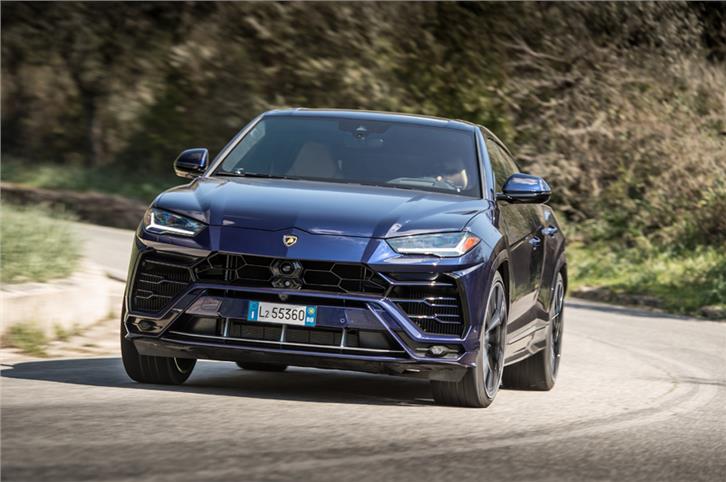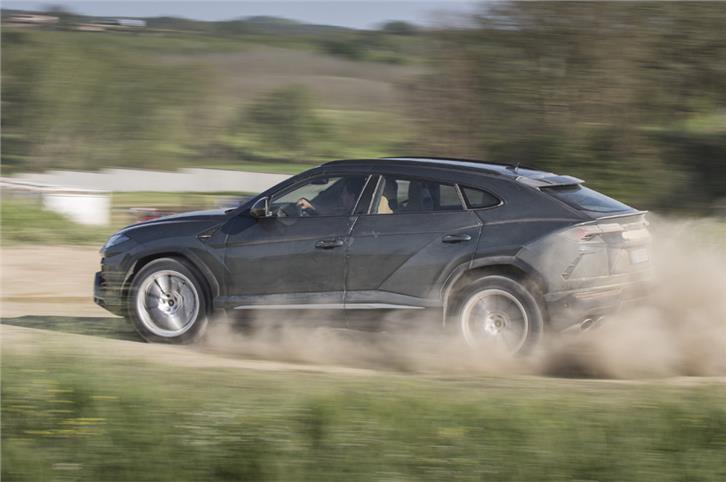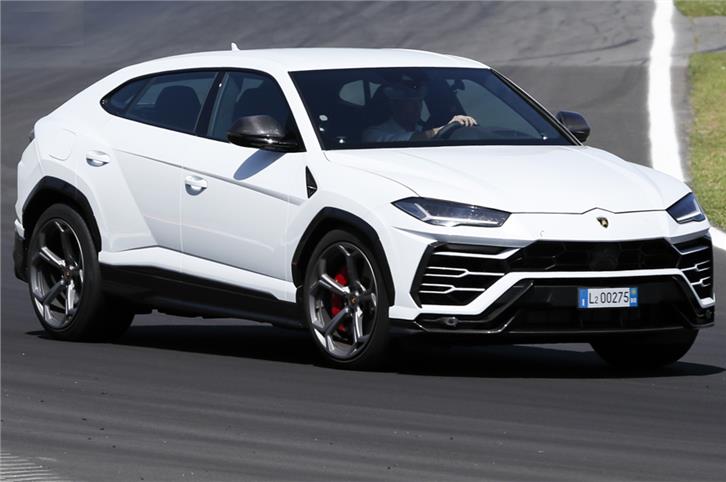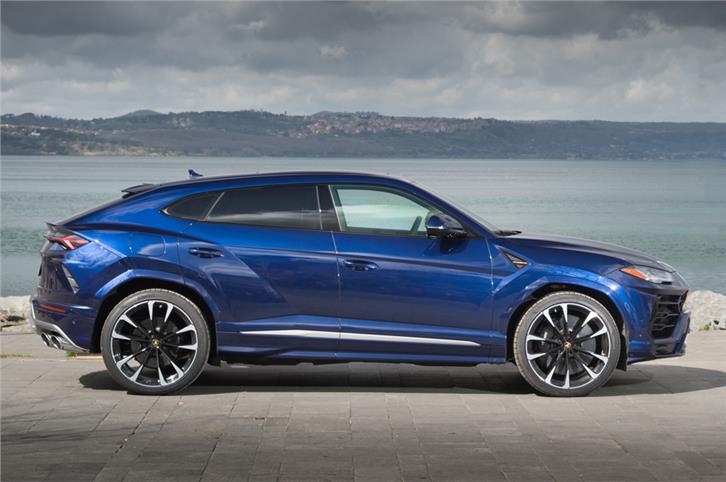It may wear the Raging Bull badge on its nose, but is the Urus truly an out-and-out Lamborghini? We drive it on track, on road and off it to find out.
Published on May 14, 2018 10:44:00 AM
28,268 Views
Follow us on
The Urus is Lamborghini's second SUV - the first was the LM002.

The Urus is a whole lot of fun on a dirt road; goes sideways with ease

Pirelli P-Zero Corsa tyres gave the Urus an immense amount of grip on-track.

It may not look like it, but the Urus is over five metres in length.
The Urus enters the party riding the wave of an SUV boom. It’s a global trend, this craze for SUVs, and in most markets they are selling hot and fast, in all sorts of shapes and sizes and at every price point. There’s demand for them even at the very top of the pyramid. And it’s this top most sliver of the market that Lamborghini wants to cash in on with the Urus. For a brand like Lamborghini, such ambitions would be unthinkable ten years ago because deviating from the rich heritage of building some of the greatest sportscars ever (Miura, Countach) into something as crass as SUVs is sacrilegious to traditionalists.
But, when the order books explode and money starts cascading straight to the bottom line, traditionalists and purists can be damned. SUVs are hugely profitable and not just the bread and butter for a car company but the jam and honey, too. It’s the reason why pedigreed brands like Porsche, Bentley, Maserati and even Rolls-Royce have all succumbed to the lure of having an SUV in their portfolio. And it's increasingly likely that Ferrari, too, will go the SUV way.
Lamborghini expects to sell around 3,500 Urus’ in the first full year after deliveries begin. With the Urus alone, Lamborghini’s production will almost double, propelling the company into a different orbit. ‘The Urus will be a new chapter in the history of Lamborghini’ says Stefano Domenicali, Chairman and CEO, Lamborghini.

The key question is, can Lamborghini inject some of its super sports car DNA into this big, brutish SUV that is taller and much heavier than its sleek, road-hugging siblings? Has platform sharing with the Audi Q7, Bentley Bentayga and Porsche Cayenne, compromised its pedigree? We look for answers on the track, on the road and even off-road.
The Urus can’t quite turn heads like say the Aventador, whose skyward-opening scissor doors offer visual drama like few other cars can. The four-door, front-engined Urus has a more conventional silhouette in comparison but being five metres long, two metres wide and sitting on the optional 23 inch rims, the largest we’ve seen on an SUV, you can’t miss it either.
The good thing is that the designers have given it all the Lamborghini design cues. A sharply sloping roofline, sharp creases, angular lines, lots of hexagonal elements and the signature Y-shaped LED daytime running lights (DRL) establish the Urus as a Lamborghini and nothing else.
You would expect the coupe-like roofline to compromise interior room but on the contrary, the cabin is genuinely spacious, in fact too spacious with enough room in the rear for a pair of six-footers. Frankly I don’t see the point of providing so much space because, the back seat in any high performance car is not a place you would encourage passengers to be unless you want to terrify them.
The driver’s seat is the place to be. It feels snug and very sporty but unlike the firm and unyielding buckets of its sports car siblings, the Urus offers more cushioning all round for the front passengers. Plucked from the Audi A8 is the high-definition, three-screen layout, which takes care of all the infotainment functions and the car settings. The instrument graphics, with their colourful, bright glow, are very Lamborghini, as are the hexagonal air vents and the dashboard’s mix of Alcantara and carbon-fibre.

Taking pride of place in the centre console is the ‘Tamburo’ (Italian for drum), which aptly describes the barrel-shaped, drive mode selectors that flank the starter button. The ‘Anima’ selector is on the left and offers a choice of six settings; three for tarmac – Strada, Sport and Corsa which offer increasing levels of intensity and three for off-road - Sabbia (sand), Terra (gravel) and Neve (Snow). There’s no Eco mode of course, but instead you get Ego mode, activated by the selector on the right. As the name suggests, it indulges you by allowing you to individually select the powertrain, steering and suspension settings, to suit your mood.
The Urus also retains possibly the best modern Lambo touch of all – the bright red, fighter jet style flap which you have to flip up to access the engine start button. You feel like a fighter pilot firing a missile. And what a missile the Urus is.
Before I blast off, let’s take quick look at some numbers. First, there’s no high-strung, high-revving V10 or V12 behind you but a 4.0-litre, twin-turbo V8 sitting upfront, developing 650hp and a monumental 850Nm of torque. The Urus tips the scales just shy of 2.2 tonnes (2,197kg to be exact) which is pretty heavy for a Lamborghini but that doesn’t hold it back from hitting a claimed 0-100kph in 3.6s and galloping on to a top speed of 305kph.
These performance figures are entirely believable the instant you prod the nicely sprung throttle pedal. Acceleration is simply savage and on the narrow country roads outside the Vallelunga circuit, the scenery becomes a blur. The rate at which the Urus builds up speed is just insane but what’s amazing is that the faster you go, the less intimidating it becomes.
The quick and sharp steering, minimal body roll and the overall weight balance (it doesn’t feel nose heavy like most SUVs) morph this massive 5 metre long, high-riding, 2.2 ton SUV into something that feels like a hot hatch. The steering isn’t as precise a tool as in the Porsche Cayenne (still the best steered SUV in the world) and your fingertips don’t get as much feedback but the ease with which I could confidently hurl the Urus down narrow roads, without upsetting its poise, felt simply magical.
The techno-wizardry Lamborghini engineers have used to mask the weight, height and size of the Urus includes active anti-roll bars, torque vectoring, adjustable damping and rear wheel steering. It’s the +/- 3 degree steering movement of the rear wheels that has a profound influence on the handling and manoeuvrability. The effect is that of virtually shortening the three metre long wheelbase by upto 600mm.
The Urus’ V8 doesn’t have the spine-tingling shriek of its V10 and V12 siblings and feels a bit muzzled in comparison, thanks to the turbos. But it’s not silent either. There’s a deep, delicious growl which transforms into a higher pitched blare as you pile on the revs. There’s a smattering of crackles and pops on the overrun, which are heightened in Corsa mode.

Playing with the various drive modes, I find Strada a bit too docile and best for highway cruising or pottering around at low speeds but what it does highlight is that the Urus is by far the most user-friendly, Lamborghini ever made. With the gearbox at its slurry best, the engine response dialed down and the suspension on the softest setting, you can actually drive the Urus like a normal, everyday car. Who could have imagined that of a Lamborghini?
But I’m not here to drive it like a normal car and on these winding country roads, I find myself settling down in Sport mode. It stiffens and drops the suspension (by 15mm), weights up the steering and switches to a more aggressive engine map. It holds onto gears longer, shifts up at the redline and downshifts with a satisfying blip too. Corsa mode lets you take control of the gearbox via the wing shaped paddles behind the steering wheel, but for road use, it’s a bit too extreme. Every upshift is accompanied by a sharp jolt, whilst downshifts from high revs can be a touch slow. Also, unlike Sport mode, which gets the gearbox software to change up at the right time, Corsa holds onto each gear until you manually upshift. But you tend hit the rev limiter because its easy to misjudge the redline which arrives too quickly and you soon realise that your driving is actually smoother and quicker toggling the Anima down to the Sport mode.
The Urus I drove on the road course was shod with the humongous 23 inch alloys, but the Pirelli P Zero tyres (285/35 ZR23 Front, 325/30 ZR 23 rear) have vulnerably slim sidewalls. They work well on smooth roads but as soon as you hit a rough patch, the ride immediately worsens. On broken tarmac, the suspension clunks and thuds and you can feel sharp edges and ruts entering the cabin. There’s no doubt smaller wheels with meatier sidewall tyres would give that crucial extra degree of compliance and improve the ‘secondary’ ride. In fact, the 23-inch rims, as gorgeous as they might look, would be too impractical for Indian roads.
Curiously, for the track, the Urus has been equipped with smaller 22-inch alloys and taller Pirelli P-Zero Corsa tyres (285/40 ZR22 front, 325/35 ZR 22 rear), possibly because this super sticky rubber isn’t available in a larger size And boy, do they grip!
On the Vallelunga circuit, the way this tall and heavy SUV deals with corners defies belief, and physics too. It was through high speed corners like the flat-out left and right sweepers after the start-finish line that the Urus took my breath away. It feels rock steady and perfectly balanced, but what makes it feel more like a sportscar than an SUV is a remarkable absence of body roll and the accuracy with which it can placed on a track thanks to the deftness of the steering, which responds brilliantly to small, precise inputs. The massive ceramic brakes, the largest you can get on production car, shed speed with eye-bulging efficiency. There’s no sign of brake fade after a few hard laps but the brake pedal had a rather spongy feel to it.
So, is the Urus a Huracan on stilts, then? Well, not quite. It’s in the tighter corners that Sir Isaac Newton eventually wins the argument with the Lamborghini engineers. Tackling the many hairpins at Vallelunga, I can feel the massive weight transfer to the outside front tyre, which squeals loudly in protest as I pile on the steering lock. It’s also on this circuit that I yearn for more revs. The 6,800rpm redline of the Urus’ twin-turbo motor is just too conservative and around Vallelunga, in Corsa mode, I was constantly head-butting the rev limiter.

Some compensation for the engine’s lack of revs is the kidney-crushing torque that slams you low down in the rev range. In fact, it felt quicker and smoother to exit the tighter corners in a higher gear, letting the torque do all the work, instead of dropping down a cog.
An SUV isn’t an SUV if it can’t be taken off-road and to prove its credentials, Lamborghini prepared an off-road course adjacent to the race circuit. But, it was more a smooth, WRC-style dirt stage with a few bumps thrown in, than a hardcore 4x4 track. Switching to Terra mode on the Tamburo, the Urus rises by 40mm but two laps of the off-road course was not so much a test of ground clearance or approach and departure angles, but to see how it handled on a loose surface.
It may not have the rock climbing or water wading capability of a Range Rover but with all that that torque on tap, the Urus gets beautifully sideways and makes you feel like Sebastien Ogier. All I can say is that driving it on smooth dirt was the most fun.
When I first saw how large the Urus is, I must admit I was a bit skeptical and had a nagging feeling that it would feel more of a generic high-performance SUV than a true-blue Lamborghini. But I am happy to say that those doubts have been dispelled.
The performance, handling, engine sound and overall looks both inside and out instantly marks out the Urus as a Lamborghini and nothing else. It’s truly magical how Lamborghini has made an SUV that can dance like something half its size and weight. What’s an even greater achievement is that honing the Urus into a blisteringly fast point A to B tool, hasn’t compromised practicality. It’s spacious enough for five adults (if you opt for the fixed bench rear seat) and can swallow a substantial amount of luggage too. It can do the office commute quite happily and yes, (whisper it) it can works as a chauffeur driven car, too.
Priced at Rs 3.10 crore (ex-showroom) the Urus isn’t cheap, but for that money, you genuinely can’t get an SUV that provides the same thrills. And the best part is that when you want, the raging bull can also be a tame bull.
Also see:
2018 Lamborghini Urus image gallery
Urus a new dimension for legendary brand says Lamborghini chairman
Lamborghini Urus first look video
Lamborghini Urus launched in India at Rs 3 crore
The Lamborghini SUV that almost went to the Dakar
Copyright (c) Autocar India. All rights reserved.

Maruti Suzuki plans to use the Boosterjet engine in more models. Which one would you like to see it in?
Comments
Member Login
Personal Details
No comments yet. Be the first to comment.